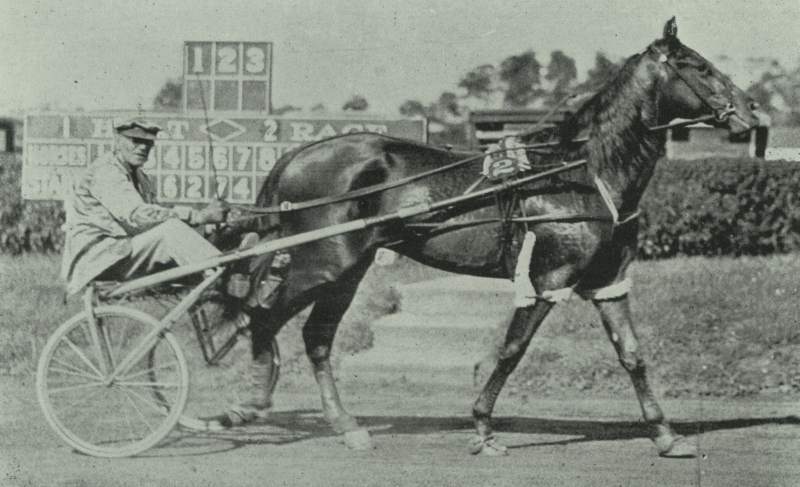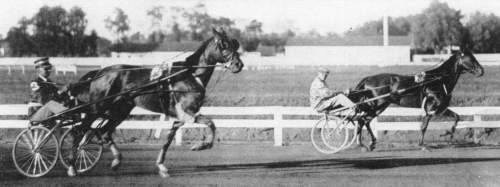Fireglow – the greastest talent ever?
by Lisa Harkema
As a two year old the smallish chestnut son of San Francisco had set a new world record for two-year-old trotters (which was equal to the time Mr McElwyn had ran in a time trial four years earlier) when winning the Junior Kentucky Futurity. In that race, Spencer had set a high tempo but faded. Down the final stretch it was a duel between Fireglow and Scotland, the former winning easily by a length in a world record 2:04 time. Depite the 1925 crop containing top trotters such as Scotland and Spencer, Fireglow had no problems mopping the floor with both of them. His superiority was such that the 1928 Hambletonian was a foregone conclusion in most people’s eyes. Walter Cox had even proclaimed Fireglow the greatest trotter he had ever trained – and few disagreed with him.
After a lengthy lay-off, Fireglow made his season debut in the $11 000 Championship Stallion Stake on North Randall on Aug 15, 1928. The colt immediately made headlines – but unfortunately for the wrong reasons. With the Hambletonian only two weeks away, he easily won the first heat in 2:04, with the last quarter in a then-impressive 29 seconds. The second heat saw an accident which James Clark, writing for the Horse Review, claimed «will go down in turf history as being marred by the worst accident that has occurred on any trotting track in many years.» Since Clark’s account is extremely detailed I quote most of it in its entirety even though he claimed that if he could «foresee what was to occur during the «One Big Day» we have been looking forward to for many weeks – I am sure that I would, for the first time in my life, have declined to write a report.». The following lengthy quote is from the August 28, 1928 edition of Horse Review:
«[Nat] Ray scored Nellie Signal fast on the outside for the second heat and they were soon on their way to a good start. Nellie rushed across and was at the pole leading when the first eighth was passed, with Fireglow trailing her closely. White was out in the track carefully looking after Scotland’s welfare going around the first turn, Childs was skinning the rail with Red Aubrey, with Guy Abbey and Gaylworthy just outside of him. After the quarter was passed in :31 1/4, they were all so closely bunched that it was with difficulty we could place them all. Between the three-eighths and the half, Dick McMahon was seen to start Guy Abbey up and Childs moved at the same time with Red Aubrey – then, it happened.
How I wish I could blot that scene from my memory! First McMahon and Guy Abbey disappeared. Then Marvin Childs’ silver coat shot high in the air, followed by the green and white of Tom Berry and the green of Fred Egan, while Harry Stokes went down from behind Gaylworthy, the colt starting on a dead run, with Red Aubrey for company. Lon McDonald, with Spencer, also crashed with the mass and went down. White, being outside of the field, in about sixth position, and Coburn right with him, escaped the smash, but there is no question but that Ben became frantic when he saw four of his drivers, Childs, Stokes’ Egan and Berry, all down in the awful wreck. Berry, after going high in the air, came down on the inside rail, balanced there a moment and then fell heavily.
Meanwhile Gaylworthy and Red Aubrey ran to and past the wire, Nellie Signal led to the seven-eigths pole where Fireglow came out from behind and won, eased up some, in 2:03 1/4 last quarter in 29 1/2 seconds, Coburn finished third, while Scotland came home with the lines loose on his back, White evidently having lost complete control of both himself and his colt.
When assistance reached the fallen horses and drivers, Dick McMahon lay under Guy Abbey semi-conscious, the colt lying himself as if dead – had he struggled the least, the chances are that Dick would have been removed to a morgue instead of a hospital. Lon McDonald’s face was bruised and cut in a fearful manner, one hand was cut open, requiring five stitches to close the wound, his body was badly bruised and a bone in his foot broken. Childs was unconscious for twenty minutes, but when he recovered consciousness refused to go to a hospital. When Harry Stokes was dragged from the track he was minus the greater part of his clothing, as, having caught in-his sulky, it was stripped from him when Gaylworthy ran away. Spencer did not struggle as the willing helpers removed him from McDonald, who escaped best. Egan called to Stokes: «Get up Harry and help me to get Dick from under his horse!» But Stokes was unable to stand, try as he would, and not until assistance arrived from the other side of the course could McMahon be extricated. All the injured drivers were taken to the Devereux «shack» and medical aid summoned, McDonald, McMahon and Berry being immediately removed to St. Alexis hospital, Cleveland, the hurts of Childs, Egan and Stokes being treated at the grounds.
None of the colts that fell was seriously injured, scratched and bruised up a little is about all that happened to them, and a strange thing to record, the four that went down and staid down, Guy Abbey, Spencer, Blonde Lady and Etta Volo, made no effort to get up until assisted to do so, and no effort to get away after getting out of the frightful tangle. Had they all plunged and kicked, as horses usually do under such circumstances, every driver in the accident would have been killed or most seriously injured. Berry has a badly crushed ankle, McMahon, in addition to his other injuries, carries the imprint of a horse-shoe on his right side, probably made by one of the two colts that ran over him. Three of his ribs were fractured.
The judges immediately started a searching investigation as to the cause of the accident. Three of the injured drivers gave their statements before being taken to the hospital, while Egan, Childs, and Stokes were quizzed later. Ben White, who witnessed the accident from the outside of the field, was in a state of hysteria and the last one to give a statement of the near-tragedy.
After two hours of investigation, the judges suspended W. R. Cox for 30 days for foul driving and disqualified his mount, Fireglow from further participation in the race, six of the drivers being unfit to continue, the trainers present and the judges and owners mutually agreeing that the race be declared finished and the money paid as the summary given shows.
The statements of witnesses of the distressing affair were that when McMahon pulled Guy Abbey out to race alongside of Fireglow, Cox pulled Fireglow out when he saw him coming and despite McMahon’s pleading of «Don’t do that, Cox!» he came out far enough to cut off Guy Abbey, causing him to fall in front of the storming field. That none of the drivers was killed instantly is a miracle.
Thus what promised to be one of the most enjoyable days for trotting horse lovers of Cleveland, and many far removed from the Fifth City of the United States, was thus terminated in gloom. Then to add to this unhappiness, the great three-year-old trotter Fireglow was taken sick forty minutes after the conclusion of the second beat of his race with what was diagnosed as acute indigestion. Dr. W. M. Sprengle, of this city, was called and every possible effort made to alleviate his suffering, which continued through Wednesday night and all day Thursday, death putting an end to his misery at ten o’clock Thursday night. A postmortem was held Friday morning and this (Friday) afternoon the great three-year-old trotter to being buried in the center field at North Randall beside the moldering remains of that other San Francisco champion, also owned in New England at the time of her death-Mary Putney. And that’s as far as I care to go with the story of our «One Big Day» at North Randall.»
Since Cox was found responsible for the accident, some suspected that retribution was behind the horse’s death. Immediately after his death it was believed that Fireglow died of acute indigestion. However, Walter Cox was certain that a youngster in such splendid physical condition as Fireglow, couldn’t possibly have succumbed to indigestion – especially considering the care taken in feeding him. As a result the body was exhumed after being buried and the stomach sent to New York.
The world didn’t just lose a great trotter. It wasn’t just the best. It was the best of the best. The 1925 crop was deep in quality, yet nobody doubted that Fireglow was superior to the rest. His pedigree was a bit unusual for a top trotter of his time and from an inbreeding perspective, in a time where Axworthy and Peter the Great were extraordinarily dominant, he would have been a great outcross addition to the stallion roster. Axworthy was his damsire but his pedigree was void of Peter the Great. In fact, had Fireglow won the Hambletonian he would have been only the third horse without Peter the Great in its pedigree to do so (the other two being Guy McKinney, the 1926 winner, and Calumet Butler, the 1931 winner). His sire, San Francisco, produced some stars, but was not the go-to stallion for great young trotters. In fact, San Francisco was often lost amid all the attention showered on Guy Axworthy and Peter Volo, but the beautiful bay stallion was a sire of renown in the post World War I era. He was also a pretty good damsire: one daughter produced Volomite, another Hambletonian-winner Peter Astra, a third the world champion Stardrift (herself the dam of Star’s Pride). The early deaths of Fireglow and St Frisco (fastest trotter in North America in 1917 and 1918), coupled with the the export (to Italy) of Hazleton meant the McKinney sireline was eventually doomed in North America.
Maternally Fireglow hails from the maternal family of famous tail female Puss Prall who belonged to John Stout of Midway, KY. Puss Prall was the dam of Lady Stout, the first three-year-old to go faster than 2:30. Sally Southworth, a full sister to Lady Stout, is the dam or Willie Wilkes (by George Wilkes), a mare that was the 4th dam of Fireglow and 7th dam of Su Mac Lad. Although by no means the strongest maternal family around, there are some good US pacers hailing from it such as Mr Wiggles, Yankee Cruiser, Doctor Butch, Mach It So and also some good trotters in Europe, most notably Swedish star filly Fridhems Ambra and Danish trotter Attention Flamingo.
The Hambletonian which was expected to be Fireglow’s instead went to Spencer in back-to-back heats, a feat he would duplicate in the Kentucky Futurity a few weeks later. He would later become a good stallion at Castleton Farm.
Meanwhile Walter Cox and owner William H Bradford of Bennington, Vermont, eagerly awaited the autopsy report. When it arrived it confirmed what Walter Cox had suspected. In fact, the findings left no room for doubt that Fireglow was poisoned. The poison used was an organic substance resembling colchicin, an alkaloid which is found in meadow saffron. Since the herb is not indigenous to North America (although colchicin is available in its chemical form), accidental poisoning was ruled out. Hartford Live Stock Insurance Company, with whom the colt was insured, investigated a bit based on this but was unable to single out any suspects. It was never determined just how the poisoning occurred. In fact, they struggled to even formulate a good theory of what had happened and, as such, they had no idea who might have pulled it off.
Some still believed it to be a freakish once-in-a-lifetime accident. According to one witness, after the race Fireglow had grassed in the track’s centerfield and ate heartily. Maybe, just maybe he had come across something in the field that killed him? Though it sounds logical, numerous accounts confirmed that other horses had grassed in the same field both that day and also before and after. Why didn’t any of them even get sick?
An article in the Indianapolis Star on December 27, 1928, responding to the autopsy report, took a cautious view, «Press reports carried widely this week respecting the examination of the stomach of the sensational but ill-fated trotting colt, Fireglow (2), 2:04, by an Eastern chemist, tend to offer a rather misleading conclusion. Though quoting only briefly from the report of the scientific man, the story which comes from Hartford, Conn., infers criminal action as a basis for the tragic death of the wonder colt, though the complete finding of the authority on the subject very definitely suggests the possibility, if not probability, of the trotter having absorbed the fatal agent if such really caused his death from other sources than human hands. Though reflecting incidentally upon the presence of minor quantities of poisons found in the contents of the stomach, all of which might easily have been given through the heroic efforts for relief by the eminent veterinary in attendance, Dr. Sprengel, the chemist dwells with particular force upon the fact that «of the organic poisons the only one found was a substance resembling the alkaloid, «colchicum» which is found in all parts of the herb meadow saffron.
The symptoms attending poisoning by colchicum are affirmed to be closely akin to those in arsenical poisoning; also, the chemist concludes that the physiological effects of this herb poison are similar to those observed by the North Randall veterinarian in the case of Fireglow. It is known to horsemen that poisoning through herbal agency has occurred before at North Randall, though fatal results had before been unknown (…) While it is not definitely known that the poison was then identified as colchicum it is reasonable to accept that agent as the prime form of destruction in the later case of Fireglow. In any case, neither the report of the chemist nor surrounding circumstances present any evidence towards criminality in producing the death of the great young trotter. Aside from the sensational phase of the race, which embraced the falling of several 3-year-olds upon the track, the serious injuries of several drivers, and the decision of the judges that Walter Cox was culpable in causing the fall, there was nothing in any way to connect the tragic passing of Fireglow a few hours later, and even if ugly thoughts rise without foundation when deeply serious happenings occur, it is obviously weirdly imaginative to erect a criminal structure upon the report from the Eastern chemist.»
The above-quoted article contains some inconsistencies with other sources, but it shows that some don’t believe Fireglow was intentionally poisoned. These days Fireglow’s death is most often described as one of «mysterious circumstances.» Not everybody is that diplomatic, however. In an article in the Bennington Banner from June 29, 1963, a small newspaper based in Bennington, Vermont (home of owner William H Bradford), there was no doubt as to what had happened:
«Poison Snuffed Out Brilliance of Fireglow (…) The «fix» is a device heavily favored by gamblers. That’s why it appears that bookmakers killed a Benaington-owned colt 35 years ago this summer. Because he was rated a sure thing to win the 1928 Hambletonian, the colt was poisoned by a ring that stood to lose $250,000 if he won. The colt, Fireglow by San Francisco, was generally regarded as the greatest of his era. He was owned by the late William H. Bradford, Bennington woolen manufacturer, and at the time of his tragic death was valued at $100,000. Chemical analysis revealed the cause of death was an alkaloid derived from a plant not native to North America, thereby ruling out accident. The drug was surreptitiously administered to the colt by an agent of the bookie ring, it was believed, although no one was ever specifically charged with the crime. Death of the young stallion not only removed a titanic figure from the harness world, but also cut off a fountainhead of classic breeding stock, thereby slowing the development of fast horses.»
The passing of time has done nothing to help solve one of the biggest mysteries in trotting history. So did somebody really intentionally kill Fireglow? Unfortunately, time will not tell and it’s inconceivable that new information could resurface in a case from 92 years ago…
What we do know is that Fireglow was a fantastic trotter who deserved to be remembered.
Picture 1: Fireglow
Picture 2: Fireglow and Scotland at 2


